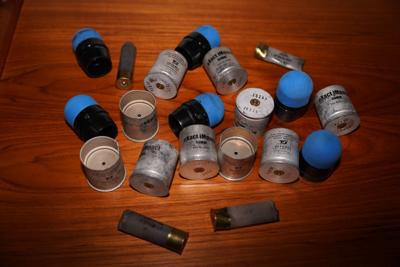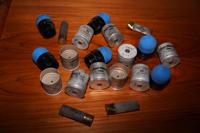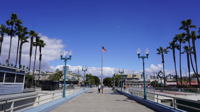
Daniel Diaz/The Santanero
The city of Santa Ana “reaffirmed” the need to have military equipment used by their police department in a 4-3 vote that took place at the city council meeting on August 19.
This comes after LAist reporting revealed the Santa Ana Police Department (SAPD) was breaking state law for two years by failing to report their use of military equipment annually. At the meeting, Mayor Valerie Amezcua and Councilmembers Thai Viet Phan, Phil Bacerra and David Penaloza voted in favor of SAPD continuing to use military equipment and move towards a drone program.
According to SAPD’s military equipment use report and emails between Commander Mathew Sorenson and a drone vendor, the department has $250,000 budgeted for the drone program. On May 7, Sorenson wrote to Flock Safety’s regional account executive Larry Barsocchini, “My total budget for the project, including hardware, software and maintenance, is $250,000.00.”
It is unclear where Sorenson’s authority on the drone fund is coming from since the city council has not approved a purchase order for the drone initiative. Sorenson did not respond to questions about this by the time of publishing.
SAPD Public Information Officer Natalie Garcia and Santa Ana city spokesperson Paul Eakins did not say where the funding will come from.
Eakins said, “If a purchase request moves forward to the City Council, the funding source will be disclosed at that time as with all City Council items involving use of city funds.”
SAPD’s military equipment use report refers to the fund as a “non-general fund source of money.”
Council member Johnathan Hernandez stated that military equipment for the police department is typically purchased with the Urban Areas Security Initiative (UASI) grant. UASI is a Department of Homeland Security (DHS) grant that is part of the Homeland Security Grant Program (HSGP). HSGP is a federal grant program administered in California by Cal OES – California Governor’s Office of Emergency Services.
Council member Benjamin Vazquez said, “There are alternatives for the use of these weapons and we must make sure we do everything we can before using them on the public but especially indiscriminately using it on protestors.”
Amezcua, Phan, Bacerra and Penaloza, who voted in favor of the military equipment, did not respond to requests for comment. Council member Jessie Lopez, who voted against the equipment, did not respond to a request for comment.
The vote comes over two months after SAPD used chemical and kinetic weapons – both carry military equipment designations – against protestors the week of June 9. Protests in Santa Ana began after state-sanctioned kidnappings by federal agents began in the Southland, including Santa Ana. SAPD’s use of military weapons against community members followed Mayor Valerie Amezcua’s statement on May 6 that indicated she would not do anything to oppose Trump’s deportation efforts resulted in over five hours of Amezcua being shamed by the public at the June 17 council meeting.
CALÓ News interviewed dozens of protestors from the June 9, 10 and 11 demonstrations in Santa Ana, they described unprovoked instances of SAPD violence, other instances of protestors throwing water bottles and fireworks at police wearing protective gear, followed by SAPD beating down or shooting people in the back, chest, limbs and head with less-lethal 40mm projectiles. They also described tear gas used by federal agents and SAPD.
According to people interviewed, SAPD’s use of military weaponry caused bruising, concussions, internal bleeding, a split finger, ankle swelling, bone fractures, bleeding and gashes exposing flesh.
SAPD’s use of force reports for the June 9 and 10 protests indicate that they also used CS gas, more commonly known as tear gas, which is banned in warfare by the Geneva convention. On June 10, the report says that kinetic munitions were used in a twelve gauge shotgun. SAPD’s reports say there were no documented injuries at the time that the reports were created, despite dozens of injuries documented by community members.
SAPD Chief Robert Rodriguez’s situation report for June 9 stated that “several” officers were hit with objects, but no serious injuries reported. He did not specify what objects officers were hit with. The report was emailed to the mayor, city council and city manager on June 10. Rodriguez did not respond to a question about whether SAPD officers suffered minor or serious injuries on June 9 or 10.
At least two people interviewed indicated that they could not seek medical attention due to financial burdens. “I tried but my Medi-Cal expired and I didn’t have the funds to do emergency [copay],” said a protestor who wished to remain anonymous due to safety concerns.
In a follow up interview, Janette Rodriguez, a protestor, mother and U.S. citizen, said she was going to the hospital again because the swelling in her ankle has not gone down since SAPD attacked her. Rodriguez described being gassed, exiting her vehicle then SAPD officers attacking her feet, which she was dragged by after falling down.
“It was very traumatic,” said Rodriguez, “that day just has a lot of trauma for the community. I still have the clothes and shoes that they ripped when they dragged me.”
Rodriguez added that her bruises and internal bleeding stemming from the attack persist. She was heading to the hospital for a follow up appointment the day CALÓ News interviewed her.
Rodrigo Gonzalez was at the June 11 protest in Downtown Santa Ana. He said a firework went off and then SAPD began “shooting at everyone.” Gonzalez said he saw a Mexican flag that was on the ground and that it “just didn’t sit right” with him to see that so he went over to grab the flag. As he reached for it, SAPD shot him with a rubber bullet. The impact opened his hand, fractured a metacarpal bone that connects the index finger to the wrist. He went to the hospital after a street medic used gauze to stop the bleeding.
Following SAPD’s violence against the community, Jacob Reisberg, Senior Policy Counsel at the American Civil Liberties Union of Southern California (ACLU SoCal) sent a letter to Chief Rodriguez about SAPD’s actions that, Reisberg says, violated state law. AB 48 is a state law that outlines the conditions that police agencies are allowed – and not allowed – to use the 40mm kinetic impact projectile launchers and tear gas that SAPD used on protestors.
Reisberg said via phone interview, “The department’s behavior, individual officers at some of these protests was totally unacceptable and had the potential to be very dangerous. If they kept shooting people in the face, if they kept shooting people without giving dispersal warnings, if they kept using chemical agents indiscriminately, people were going to get direly hurt.”
Chief Rodriguez responded by asserting that SAPD is “fully aware of the requirements for the use of kinesthetic energy projectiles and chemical agents and our officers have at all times followed the law.”
He did not address the ACLU SoCal’s specific concerns about the conditions that state law requires for 40mm launchers and tear gas to be used – conditions that ACLU SoCal’s letter says were unmet. Instead, Chief Rodriguez listed what SAPD officers allegedly went through at the hands of “some-not all-protestors [sic].”
Reisberg added, “The law on this is not that complicated. You just look at AB 48, you look at the videos of what happened and you say, ‘Did they violate this?’ And to me, the answer is obviously ‘yes.’”











(0) comments
Welcome to the discussion.
Log In
Keep it Clean. Please avoid obscene, vulgar, lewd, racist or sexually-oriented language.
PLEASE TURN OFF YOUR CAPS LOCK.
Don't Threaten. Threats of harming another person will not be tolerated.
Be Truthful. Don't knowingly lie about anyone or anything.
Be Nice. No racism, sexism or any sort of -ism that is degrading to another person.
Be Proactive. Use the 'Report' link on each comment to let us know of abusive posts.
Share with Us. We'd love to hear eyewitness accounts, the history behind an article.